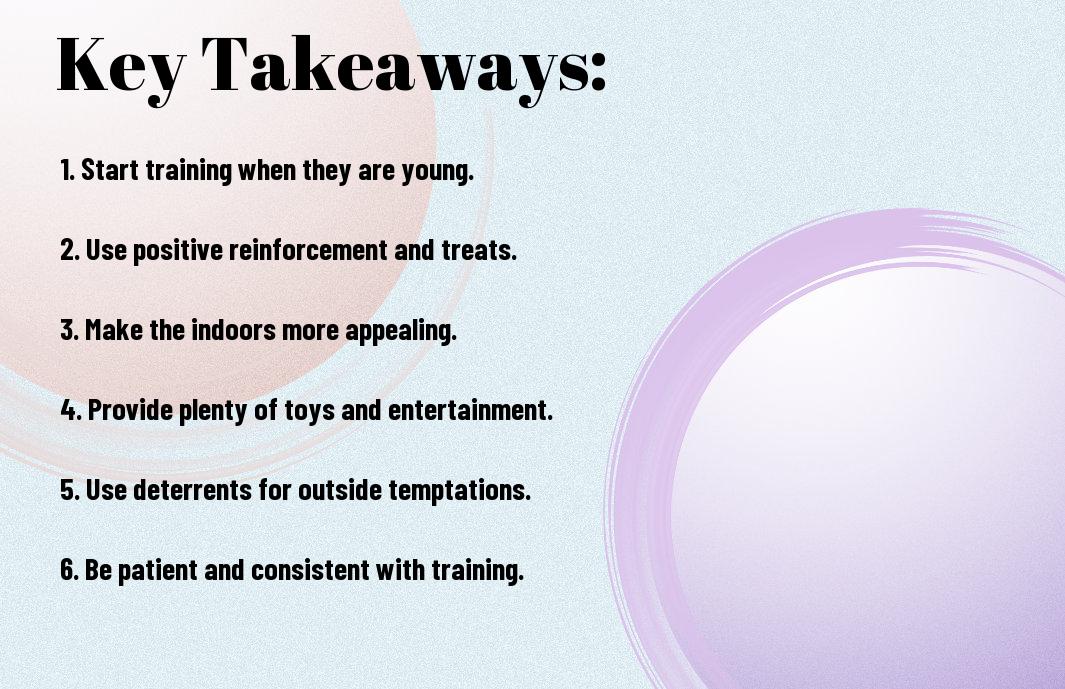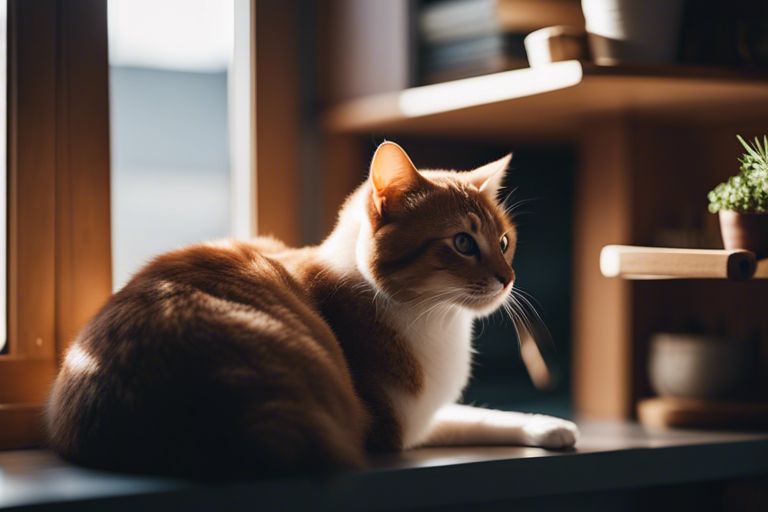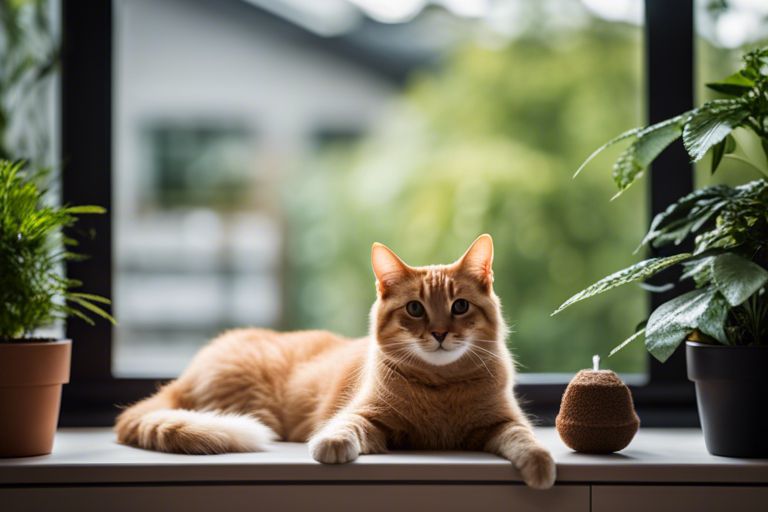Are you tired of your cat constantly running out the door as soon as it’s open? Keeping your cat indoors is not only safer for them, but it also helps protect them from dangers such as cars, predators, and diseases. Training your cat to stay indoors may seem challenging, but with consistency and patience, it can be done. By using positive reinforcement, creating a stimulating environment, and providing plenty of toys and attention, you can help your cat adjust to a happy, healthy indoor lifestyle.
Key Takeaways:
- Consistency is key: Establish a routine for feeding, playtime, and attention to help your cat feel secure and content staying indoors.
- Provide mental and physical stimulation: Offer a variety of toys, scratching posts, and interactive play to keep your cat entertained and prevent boredom.
- Use positive reinforcement: Reward good behavior with treats or praise, and avoid punishment as it can create fear or anxiety in your cat.
- Create a cat-friendly environment: Set up cozy resting spots, high vantage points, and safe outdoor access such as a screened-in porch to meet your cat’s natural instincts while remaining indoors.
- Consider enlisting professional help: If your cat continues to show signs of stress or struggles with the transition to staying indoors, consult with a veterinarian or animal behaviorist for expert guidance.


Preparing Your Home
While training your cat to stay indoors, it’s important to prepare your home to create a safe and stimulating environment for your feline companion. This includes making necessary adjustments to ensure your cat is comfortable and entertained while staying inside.
Cat-Proofing the Indoor Environment
When preparing your home for your indoor cat, it’s essential to cat-proof your living space. This means securing any potential escape routes such as windows and doors, ensuring that they are always closed or fitted with reliable screens. Additionally, you should carefully check for any hazardous items such as small objects or toxic plants that could harm your cat if ingested.
Essential Indoor Enrichment for Cats
Creating an enriching environment for your indoor cat is crucial for their well-being. Provide plenty of vertical space for your cat to climb and explore, such as cat trees or shelving. Additionally, ensure that your cat has plenty of stimulating toys and interactive playthings to keep them mentally and physically engaged. Consider setting up scratching posts to help fulfill their natural desire to scratch and maintain their claws while indoors.

Training Techniques
Despite what some people may think, it is possible to train a cat to stay indoors. It simply requires patience, consistency, and the use of effective training techniques. In this chapter, we will explore some of the most successful methods for training your feline friend to be an indoor cat.
Positive Reinforcement Methods
When it comes to training your cat to stay indoors, positive reinforcement is key. This involves rewarding your cat for good behavior, such as staying inside the house. Whenever your cat chooses to stay indoors voluntarily, be sure to praise and reward them with treats, petting, or playtime. Over time, your cat will learn that staying indoors leads to positive experiences, making them more likely to continue this behavior.
Discouraging Outdoor Escapes
To discourage your cat from trying to escape outdoors, it’s important to make the outside environment less appealing. This can be achieved by closing off any escape routes in your home, such as windows and doors, to limit your cat’s access to the outside. You can also create a safe and engaging indoor environment for your cat by providing plenty of toys, scratching posts, and climbing trees. By making the indoors more stimulating and comfortable, your cat will be less inclined to seek outdoor adventures.
Maintaining Indoor Living
Your cat has successfully transitioned to indoor living, but it’s important to continue providing a stimulating and comfortable environment for them. Ensuring they have plenty of toys, scratching posts, and cozy spots to rest will keep them content indoors. It’s also crucial to maintain a healthy routine of play and interaction with your cat to prevent boredom and keep them mentally and physically stimulated.
Routine Health Checks and Care
Regular health check-ups are essential for all cats, but especially for indoor cats who may not have the same access to outdoor experiences. Ensure you schedule annual veterinary appointments for vaccinations, parasite prevention, and overall wellness exams. Additionally, it’s important to maintain a healthy diet and monitor your cat’s weight to prevent obesity, which can lead to various health issues. Regular grooming and dental care are also crucial for their overall well-being.
Managing Cat’s Outdoor Desires Long-Term
As time goes on, it’s natural for your indoor cat to express a desire to explore the outdoors. It’s important to continue providing mental stimulation and engagement to keep them satisfied indoors. Consider creating a safe outdoor enclosure or cat-proofing your backyard to allow them supervised outdoor time. Always supervise your cat when outdoors to ensure their safety and prevent them from wandering off. Look for signs of restlessness or boredom and find new ways to keep them entertained and fulfilled indoors.
Training Your Cat to Stay Indoors
With this in mind, there are several methods you can use to train your cat to stay indoors. Using deterrents such as noisy or motion-activated devices can help discourage your cat from wanting to go outside. Additionally, providing plenty of mental and physical stimulation indoors through toys, climbing structures, and interactive play can help satisfy your cat’s natural instincts. Consistency and patience is key when training your cat, as well as rewarding good behavior with treats and positive reinforcement. By implementing these strategies, you can successfully train your cat to stay indoors and keep them safe. Remember, it may take time and effort, but it is possible to train your cat to be a happy indoor pet.
FAQ
Q: Why is it important to train my cat to stay indoors?
A: Training your cat to stay indoors is important for their safety and well-being. Indoor cats are less likely to be exposed to predators, traffic, and diseases. It also helps to prevent them from causing harm to wildlife and reduces the risk of them getting lost or stolen.
Q: How can I train my cat to stay indoors?
A: Start by creating a stimulating indoor environment for your cat with plenty of toys, scratching posts, and perches. Gradually limit their outdoor access by only allowing supervised outdoor time on a harness or in a secure enclosure. Use positive reinforcement, such as treats and praise, to encourage them to stay indoors and redirect any attempts to go outside.
Q: What are some tips for successfully training my cat to stay indoors?
A: Be patient and consistent with your training efforts. Provide mental and physical stimulation for your cat indoors to prevent them from getting bored. Ensure that your home is secure, with no easy escape routes for your cat. Consider using deterrents, such as motion-activated devices or unpleasant smells, to discourage your cat from trying to leave the house.

Jayley, a devoted cat enthusiast, also writer for other cat blog as well. She aims to dedicated to providing comprehensive information, insights, and advice on everything you’d ever want to know about our whiskered companions.
